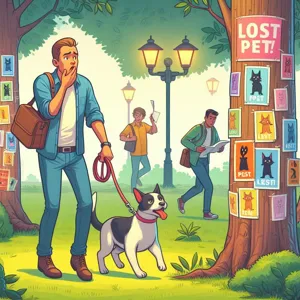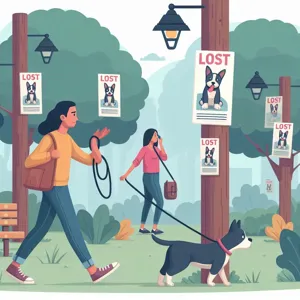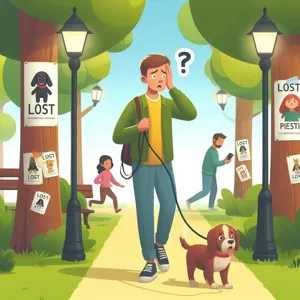Losing a beloved pet can be one of the most heart-wrenching experiences a pet owner can face.
The frantic search, the worry, and the longing to have your furry friend safely back in your arms can be overwhelming. However, time is of the essence, and knowing how to act quickly and effectively can make all the difference in reuniting with your lost companion. In this blog post, we highlight ten effective strategies that will empower you to find your lost pet fast. From leveraging social media platforms and local community networks to using innovative tracking tools and creating attention-grabbing flyers, we’ll provide you with actionable tips that can help you navigate this distressing situation. Don’t lose hope—read on to discover the essential steps you can take to bring your pet home safely and swiftly!
1. Stay Calm and Assess the Situation

When your beloved pet goes missing, the initial wave of panic can be overwhelming. However, taking a moment to breathe and stay calm is crucial. Anxiety can cloud your judgment and hinder your ability to think clearly. Start by assessing the situation: Where was your pet last seen? What time did you notice they were missing? Did they have any identifiable features or tags that could assist others in recognizing them?
Once you’ve gathered your thoughts, retrace your steps. Check the areas where your pet typically roams, such as the backyard, nearby parks, or even the neighbors’ yards. Pets often seek out familiar surroundings, so a thorough search of these places can be beneficial.
Additionally, consider the weather and time of day. If it’s getting dark, your pet may be frightened and hiding. On the other hand, if it’s daytime, they might be exploring out of curiosity. Look for signs of your pet, such as overturned trash cans or disturbed foliage, which could indicate where they might have wandered.
Remember, the more organized and calm you are in your search efforts, the more effective you’ll be in finding your furry companion. By taking these first steps with a clear mind, you can initiate a focused and efficient search, increasing the chances of reuniting with your lost pet swiftly.
2. Create a Detailed Description a your lost pet
When it comes to reuniting with your lost pet, a well-crafted description can make all the difference. Start by including essential details such as your pet’s name, breed, age, size, and color. Be specific—mention any distinctive markings, such as spots, stripes, or unique features like a crooked tail or an unusual nose. If your pet has a collar, describe its color and any tags attached, as well as whether your pet is microchipped.
Next, consider your pet’s personality and behavior. Is your dog friendly and approachable, or is your cat skittish around strangers? Highlighting these traits can help potential finders know what to expect and may encourage them to approach your pet if they spot them.
For maximum effectiveness, craft a concise yet detailed description that can be easily shared across various platforms—social media, neighborhood flyers, and community boards. Use clear language and avoid jargon that might confuse people who are trying to help. Pair your description with a recent photo of your pet, ideally one that showcases their features clearly.
Lastly, don’t forget to include your contact information and any relevant details about where they were last seen. The more information you provide, the better chance you have of getting your beloved companion back safely. Act quickly and disseminate your detailed description widely—time is of the essence when it comes to finding your lost pet!
3. Utilize Social Media Platforms to talk about your lost pet

In today’s digital age, social media platforms are powerful tools that can greatly enhance your search for a lost pet. Harnessing the reach and immediacy of platforms like Facebook, Twitter, Instagram, and Nextdoor can significantly increase your chances of locating your furry friend.
Start by creating a compelling post that includes a clear, recent photo of your pet, along with a detailed description. Mention their name, breed, size, color, and any distinctive features that might help people identify them. Don’t forget to include your contact information and the area where your pet was last seen. The more details you provide, the better!
Once your post is created, share it on your personal profile and in local community groups. Many neighborhoods have dedicated pages for lost and found pets, where residents actively help each other. Engaging with these communities can help you tap into a network of caring individuals who are on the lookout for your lost pet.
Encourage your friends and family to share your post to broaden its reach. The power of social sharing can turn a single post into a viral alert, exponentially increasing the number of eyes looking for your pet.
Don’t forget to utilize relevant hashtags like #LostPet, #FindMyDog, or #MissingCat, as these can help your post gain visibility among those who specifically follow such content. Additionally, consider creating a dedicated page for your lost pet, where you can post updates and information, making it easier for people to follow along and remain engaged in the search.
Moreover, many local shelters, rescue organizations, and pet-related businesses monitor social media for reports of lost pets. Tagging these organizations in your posts can help spread the word further and faster.
By utilizing social media effectively, you can mobilize your community, spread the word quickly, and keep hope alive in your quest to find your beloved pet.
4. Post on Local Community Groups
When it comes to the search for your lost pet, leveraging the power of local community groups can be a game-changer. These groups, often found on social media platforms like Facebook, Nextdoor, and even local forums, are bustling with residents who are eager to help one another. Start by joining groups dedicated to your neighborhood or city, as well as those specifically focused on lost and found pets.
Crafting a compelling post is key. Include clear, recent photos of your pet from different angles, as well as a detailed description that highlights any unique features or identifying marks. Make sure to specify where and when your pet was last seen, and if applicable, mention any behavioral quirks that might help others identify your furry friend.
Engaging your audience is equally important. Ask people to keep an eye out and share your post to expand your reach. Don’t hesitate to post regular updates, as this keeps your pet’s situation fresh in the minds of community members. Many groups have a strong sense of camaraderie, and your heartfelt plea may inspire others to join in the search.
Additionally, keep an eye on the comments section of your post. Community members may respond with tips, sightings, or even advice from their own experiences. The collective effort of a community can significantly increase your chances of finding your lost pet quickly, as the more eyes that are looking, the better!
5. Notify Local Shelters and Vets

When your beloved pet goes missing, time is of the essence, and one of the most crucial steps you can take is to notify local shelters and veterinary clinics. These establishments often serve as the first line of defense for lost animals, housing many pets that are found wandering the streets or reported by concerned citizens.
Start by compiling a list of nearby animal shelters and rescue organizations. Many communities have dedicated facilities where lost pets are brought in, and by reaching out to them promptly, you increase the chances of your furry friend being safely returned. Provide the shelter staff with a detailed description of your pet, including their breed, color, size, and any distinguishing features or unique markings. A photo of your pet can significantly enhance your chances, making it easier for the staff to recognize them if they come in.
In addition to shelters, don’t forget to reach out to local veterinary clinics. Many vets keep a record of lost and found pets, and they often check for microchip information when a pet is brought in. If your pet is microchipped, make sure you inform the clinic of the chip number so they can easily access your contact information. Even if your pet isn’t chipped, vets can help by sharing your pet’s information with their network, as they frequently interact with the local community.
Establishing a rapport with these facilities is essential. Provide your contact information and let them know you are actively searching for your pet. Some shelters and vets may even have a lost and found bulletin board or social media pages where they post updates about animals that have been brought in—ask if they can share your pet’s information on these platforms.
By notifying local shelters and veterinarians, you’re casting a wider net in your search efforts. Remember, the sooner you reach out, the better your chances of being reunited with your furry companion. Every minute counts, so take action quickly and keep hope alive!
6. Distribute Flyers in the Neighborhood for your lost pet
Distributing flyers in your neighborhood is one of the most effective and traditional methods to spread the word about your lost pet. When creating your flyers, ensure they are eye-catching and informative. Use a clear, recent photo of your furry friend—this visual identification can make all the difference. Highlight key details like your pet’s name, breed, color, size, and any distinctive markings or features that would help someone recognize them.
Include your contact information prominently, such as your phone number and email address, so that anyone who spots your pet can reach out to you quickly. Consider adding a reward offer; even a small incentive can motivate neighbors to keep an extra eye out for your beloved companion.
Once your flyers are ready, take a walk around your neighborhood. Post them on community bulletin boards, at local pet shops, veterinary offices, and even in grocery stores. Don’t forget to knock on doors and speak with your neighbors—personal interaction can help generate more awareness and encourage people to keep their eyes peeled for your lost pet.
Additionally, think about expanding your reach to nearby parks and popular walking routes where pet owners commonly gather. The more people who see your flyer, the greater the chances of a sighting. Remember, a little bit of effort can lead to a heartwarming reunion, so don’t hesitate to get those flyers out there!
7. Search Your Neighborhood Thoroughly

When your beloved pet goes missing, the first step is to rally your efforts in searching your immediate neighborhood thoroughly. This area is likely where your furry friend wandered off, so it’s crucial to leave no stone unturned. Start by retracing your steps and visiting the places where your pet often roams, such as your backyard, nearby parks, or the local spots where they enjoy their daily walks.
As you venture out, bring along some of your pet’s favorite treats or toys to help coax them out if they’re hiding nearby. Their familiar sounds or scents can often lure them back to you. Pay attention to any hiding spots they may favor, like under porches, in bushes, or behind parked cars. Cats, in particular, are known for seeking shelter in small, enclosed spaces, while dogs might prefer to explore further afield.
Additionally, enlist the help of your neighbors. A quick chat with them can make a significant difference; they might have seen your pet or can assist in the search. Consider creating flyers with clear photos of your pet and your contact information to distribute around the area. Make sure to include distinctive features that will help others recognize your pet instantly.
While searching, keep your spirits up and remain hopeful. You never know when a friendly neighbor might spot your pet and reach out. The more eyes you have on the lookout, the better your chances of a swift reunion. Remember, thoroughness in your search can significantly increase the likelihood of bringing your lost pet home safely.
8. Talk to Neighbors and Local Businesses about your lost pet
When a beloved pet goes missing, the immediate instinct is often to search frantically. However, one of the most effective—and often overlooked—strategies is to engage with your community. Talking to neighbors and local businesses can significantly enhance your chances of finding your lost furry friend.
Start by reaching out to your immediate neighbors. They may have seen your pet wandering in the area or could offer a fresh set of eyes to help in the search. Create a simple flyer featuring a clear photo of your pet, a brief description, and your contact information. Hand these out personally, and don’t hesitate to share any distinctive traits that might help others recognize your pet quickly. Be friendly and approachable; people are more likely to assist you if they feel a personal connection.
Next, expand your outreach to local businesses. Visit nearby shops, cafes, and community centers, and ask if you can post your flyer on their bulletin boards or display windows. Many local business owners are willing to help community members in distress, and they may even have their own networks to share information. It’s a good idea to leave a flyer with them as well, so they can keep an eye out while they go about their daily routines.
Also, consider engaging with local social media groups or neighborhood apps like Nextdoor. Post an update about your lost pet, and encourage your community to share your message. The more people who are aware, the better the chances of someone spotting your pet and contacting you. Remember, the power of community can be a game changer in your search, so don’t hesitate to tap into those resources. The combined efforts of your neighbors and local businesses can create a network of vigilance that could lead you back to your beloved companion sooner than you think.
9. Use Pet Tracking Technology
In today’s digital age, pet tracking technology has revolutionized the way we keep tabs on our furry friends. These innovative devices can provide peace of mind and significantly increase your chances of finding a lost pet quickly. One of the most popular options is GPS collars, which allow you to track your pet’s real-time location via smartphone apps or websites. These collars are lightweight and comfortable, ensuring that your pet won’t even notice they’re wearing it—except for the added security it provides.
If a GPS collar isn’t suitable for your pet, consider using microchipping. While it doesn’t offer real-time tracking like GPS, microchips provide a permanent form of identification. If your pet is found and taken to a vet or shelter, they can be scanned for a microchip, which contains your contact information. This small, simple procedure can make a world of difference in reuniting you with your lost companion.
Additionally, some pet owners are turning to smart identification tags that connect to your smartphone. These tags can include QR codes that lead to your pet’s profile, including their name, medical information, and your contact details. With just a quick scan, good Samaritans can help ensure your pet is returned home safely.
Investing in pet tracking technology is not just a precaution; it’s a proactive way to safeguard your beloved pet. By leveraging these tools, you can significantly improve your chances of a swift reunion, allowing you to enjoy more time together and less time worrying. Whether you choose a GPS collar, a microchip, or smart tags, embracing technology can make all the difference when it comes to locating your furry family member.
10. Set Up a Scent Trail
Setting up a scent trail can be a surprisingly effective method to help your lost pet find its way back home. Animals, especially dogs and cats, rely heavily on their sense of smell, and using this instinct to your advantage can make a significant difference in your search efforts.
To create a scent trail, start by gathering items that carry your pet’s unique scent. This could include their favorite blanket, bed, or a piece of your clothing. If your pet has a favorite toy, that can work too. The goal is to use familiar scents that evoke a sense of comfort and recognition.
Once you have your items, strategically place them around your neighborhood, particularly near areas where your pet was last seen. Leave a trail leading back towards home, as this can encourage your pet to follow the familiar scents back to safety. Be sure to place the items in a secure location, such as your yard or nearby bushes, where they won’t be easily disturbed by other animals or people.
In addition to setting up a scent trail, consider using a few drops of your pet’s favorite food or treats along the way to entice them to return. This can be especially effective if your pet is food-driven.
Combine this method with other strategies, such as posting flyers and utilizing social media, to increase your chances of a successful reunion. Remember to remain hopeful and be patient; animals have a remarkable ability to find their way home, especially when guided by the scents they know and love.
11. Leverage Local Lost and Found Pet Websites for your lost pet
In today’s digital age, leveraging local lost and found pet websites can significantly increase your chances of locating your furry friend quickly. These platforms serve as communal hubs where pet owners, animal shelters, and concerned citizens can post sightings or reports of lost and found pets in your area. By tapping into this resource, you’re not only accessing a wide audience but also connecting with individuals who share your urgency and compassion.
Start by researching specific websites dedicated to lost and found pets in your locality. Many communities have their own dedicated social media groups or forums where members actively share information about lost animals. Websites like PawBoost, LostMyDoggie, and even Facebook groups can be invaluable. Create a clear and compelling post that includes a recent photo of your pet, a detailed description, and your contact information. Make sure to highlight any unique traits that may help others recognize your pet.
In addition, don’t shy away from utilizing broader platforms like Nextdoor, which connects neighbors in your community. Posting on these platforms not only spreads the word but also engages your immediate community, encouraging them to keep an eye out for your pet as they go about their daily routines.
Make it a point to regularly check these websites and groups for any updates or sightings. The more proactive you are, the better your chances of reuniting with your beloved companion. Remember, your pet may have wandered into a neighbor’s yard or a nearby park, and the more eyes that are watching, the more likely you are to receive a tip that leads you to them. By leveraging these local resources effectively, you can mobilize a supportive network that works together to bring your pet home safe and sound.
12. Check Online Classifieds and Forums
When a beloved pet goes missing, the emotional turmoil can be overwhelming, but there are practical steps you can take to expedite their return. One of the most effective strategies is to tap into online classifieds and community forums. Websites like Craigslist, Facebook Marketplace, and local community groups are invaluable resources for pet recovery.
Start by posting a detailed description of your lost pet, including clear photos, their name, breed, color, size, and any distinguishing features. Be sure to include your contact information and the area where your pet was last seen. When crafting your post, consider adding a heartfelt message that conveys your bond with your pet; this personal touch can resonate with readers and encourage them to keep an eye out for your furry friend.
In addition to posting your own lost pet ad, be proactive by browsing through found pet listings in these classifieds and forums. You might come across someone who has spotted your pet or even someone who has taken them in. Many communities have dedicated Facebook groups for lost and found pets, where local members actively share sightings and updates. Engaging with these groups can provide valuable insights from fellow pet owners who understand the urgency of your situation.
Remember to keep your posts updated with any new information, such as changes in the search area or additional reward offers. The more visibility you create, the better your chances of reuniting with your pet. By leveraging the power of online classifieds and community forums, you’re not just spreading the word—you’re building a network of support that can help bring your cherished companion home.
13. Keep Searching and Stay Persistent
When it comes to finding your lost pet, persistence is your greatest ally. The initial days of searching can be overwhelming, filled with a whirlwind of emotions, but it’s crucial to maintain a steady focus. Start by creating a daily routine that includes searching in different areas at various times of the day. Pets can wander into unexpected places, so exploring your neighborhood, nearby parks, and even local businesses is vital.
Each search should be thorough but also mindful. Call your pet’s name while you search, using a calm and reassuring tone that they’ll recognize. Bring along their favorite toy or a treat that might entice them to come out of hiding. Don’t hesitate to enlist the help of friends and family—more eyes on the ground can significantly increase your chances of spotting your furry friend.
Moreover, don’t forget to revisit places you’ve already checked. Pets can sometimes return to familiar spots, so your persistence might pay off in unexpected ways. Keep in touch with local shelters and veterinary offices, providing them with updated descriptions and photos of your pet. Regularly updating your social media posts and community boards can also keep your pet in the minds of those who might see them.
Remember that every moment spent searching is a step closer to reuniting with your beloved companion. Stay hopeful, remain proactive, and let your determination shine through. This journey can be challenging, but your efforts are crucial in bringing your pet back home safely.
14. What to Do If You Find Your Pet
If you’re fortunate enough to find your lost pet, the relief and joy can be overwhelming. However, it’s essential to approach the situation with care and composure to ensure a smooth transition back to home. Here’s a step-by-step guide on what to do if you find your furry friend.
**1. Stay Calm and Assess the Situation:**
When you spot your pet, take a moment to breathe and gather your thoughts. If they seem frightened or skittish, approach slowly and speak softly. Avoid sudden movements that might startle them, especially if they’re in an unfamiliar environment.
**2. Secure Your Pet:**
Once you’re close enough, gently coax your pet to you with calming words, a familiar sound, or a favorite toy. If they are wearing a collar with identification tags, ensure they are still secure. If your pet is frightened or resistant, consider using a leash or carrier to safely transport them home.
**3. Check for Injuries:**
After you’ve brought your pet home or to a safe space, thoroughly check them for any injuries or signs of distress. Look for cuts, bruises, or signs of dehydration. If you notice anything concerning, don’t hesitate to take them to a veterinarian for a thorough check-up.
**4. Reintroduce Them to Home:**
Once home, allow your pet some time to acclimate. They may be anxious or disoriented after their adventure. Create a safe, quiet space for them to relax, and gradually reintroduce them to their familiar surroundings. Offer their favorite food and plenty of water, helping them feel comfortable and secure.
**5. Update Their Microchip Information:**
If your pet has a microchip, it’s crucial to update your contact information if it has changed. This step ensures that you can be reached in case your pet gets lost again in the future.
**6. Share the Good News:**
After reuniting, celebrate your time together! Share the good news with friends and family, and consider posting on social media to inform your community that your beloved pet has been found. This not only spreads joy but also helps others who might be searching for their own lost pets.
**7. Reflect on Preventive Measures:**
Finally, take this experience as an opportunity to reinforce preventive measures. Consider investing in a GPS collar, updating tags, or enhancing your yard’s security. By taking these steps, you can help ensure that your pet stays safe and sound in the future.
Finding your pet can be an emotional rollercoaster, but by following these steps, you can ensure a safe and happy reunion. Celebrate the bond you share and cherish every moment together!
15. Preventive Measures for the Future
Losing a pet can be one of the most distressing experiences a pet owner can face. While the immediate focus is often on finding your beloved companion, it’s crucial to also think about preventive measures for the future. By implementing a few simple strategies, you can significantly reduce the risk of losing your pet again.
First and foremost, consider investing in a high-quality collar with an ID tag that includes your contact information. Ensure that the collar fits properly and cannot easily slip off. Additionally, microchipping your pet is an effective and permanent solution for identification. Microchips are small, easily implanted devices that provide a unique identification number linked to your contact details, allowing shelters and vets to quickly reunite you with your furry friend.
Creating a secure environment at home is equally important. Regularly check your fences and gates for any gaps or weak spots that could allow your pet to escape. If you have a garden, consider installing pet-proof fencing that is tall enough and designed to keep even the most determined escape artists at bay.
Training your pet to come when called can also be a lifesaver. Consistent recall training not only helps maintain a strong bond with your pet but also ensures they stay close when they’re off-leash in a park. Finally, consider using a GPS tracking device for added peace of mind. These devices can provide real-time location updates on your pet, making it easier to locate them should they wander off.
By taking these preventive measures, you can help safeguard your pet’s safety and ensure that your home remains a loving sanctuary for your furry family members. Remember, a little foresight can go a long way in keeping your pets secure and giving you peace of mind.
In conclusion, losing a beloved pet can be an incredibly distressing experience, but by employing the strategies outlined in our blog post, you can significantly increase your chances of a swift reunion. From leveraging social media and local community networks to using scent trails and posters effectively, every step you take can make a difference. Remember, persistence is key—don’t lose hope, as many pets are found days, even weeks after they go missing. We encourage you to act quickly, remain positive, and tap into the support of your community. Here’s to reuniting with your furry friend and bringing them back home where they belong!






